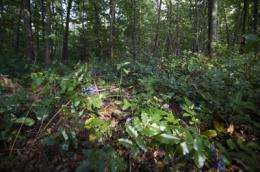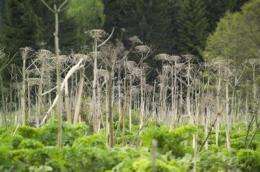Europe's flora is becoming impoverished

With increasing species richness, due to more plant introductions than extinctions, plant communities of many European regions are becoming more homogeneous. The same species are occurring more frequently, whereas rare species are becoming extinct. It is not only the biological communities that are becoming increasingly similar, but also the phylogenetic relations between regions. These processes have led to a loss of uniqueness among European floras, scientists from the DAISIE research project have published their findings in the current online edition of the scientific journal Proceedings of the National Academy of Sciences (PNAS).
For their research the scientists analysed the data of flora native to Europe (Flora Europaea), extinct plant species (national red lists) and alien plant species from the DAISIE database (www.europe-aliens.org). About 1,600 new non-European species were introduced to the approx. 11,000 native European plant species since 1500 A.D.
The researchers also took into account those European plants that are native to a particular region of Europe but considered as introduced species in another (approx. 1,700. It works in a similar way for the species considered to be "extinct". While in the whole of Europe only 2 plant species can "really" be considered as extinct, approx. 500 species have become locally extinct. One such example is the Blue Woodruff (Asperula arvensis), a weed that grows on cultivated land, which has been greatly displaced particularly from the intensification of agricultural practices. This species is considered to be locally extinct in Germany and Austria for example, whereas it still occurs e.g. in Italy and Spain.
The researchers were able to demonstrate, that biodiversity is increasing in all regions of Europe due to high numbers of alien species. But at the same time the plant communities of the regions are becoming increasingly more homogenous because alien species are distributed relatively consistently over the continent. The remarkable thing is that it is not only the diversity between plant communities that is decreasing (taxonomic homogenisation), but also the phylogenetic diversity.. Phylogenetic diversity reflects the evolutionary history of a community and therefore also its genetic diversity, which can also be an expression of its functional diversity.
A phylogenetic tree with high diversity can be imagined as a genealogical tree with a protruding crown, with many strong branches (distantly related species) and numerous twigs (many species). A high phylogenetic and taxonomic diversity (many tree species that look different), presents a wealth of information and ability, making it possible for biological communities to react to environmental changes, like those arising for example from the current global climate change (e.g. climate or land use change). If one finds many very similar looking trees, then one assumes that the flexibility of the communities is no longer as high to be able to react positively to these changes. Put simply: the genealogical tree of the plant species occurring in Europe has got more twigs, but these only sprout from a few large branches.

Biological depletion from loss of species and introduced species is a consequence of global change associated with increasing pressure on the environment (e.g. the intensification of agriculture, the loss of habitat diversity, urbanisation, increasing global traffic and excessive nutrient influx into ecosystems).
"Our studies have shown that in spite of an increase in regional species richness due to species introductions exceeding the local extinctions of plant species in European regions, these are increasingly losing both their phylogenetic and taxonomic uniqueness", according to Dr. Marten Winter from the Helmholtz Center for Environmental Research (UFZ). "In all discussions on ,biodiversity' one needs to consider other forms of biodiversity than pure species richness e.g. those of phylogenetic relations. These can supply additionally important information about the condition and possible risks to ecosystems ", the researcher adds.
Over the last few years, the EU project DAISIE (Delivering Alien Invasive Species Inventories for Europe) has gathered for the first time information on all known alien species across Europe. Information on the ecology and distribution of alien plant and animal species was collected and has been made available for interested parties via an Internet database. Research institutes and organizations from 15 nations were involved in the project.
More information: Marten Winter, Oliver Schweiger, Stefan Klotz, Wolfgang Nentwig, Pavlos Andriopoulos, Margarita Arianoutsou, Corina Basnou, Pinelopi Delipetrou, Viktoras Didziulis, Martin Hejda, Philip E. Hulme, Phil Lambdon, Jan Pergl, Petr Pysek, David B. Roy and Ingolf Kühn (2009). Losing uniqueness: Plant extinctions and introductions lead to phylogenetic and taxonomic homogenization of the European flora. Proceedings of the National Academy of Sciences (PNAS), www.pnas.org/content/early/200 … /0907088106.abstract
Source: Helmholtz Association of German Research Centres (news : web)
















